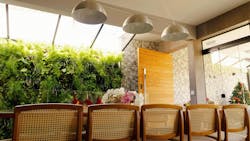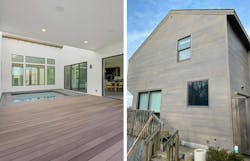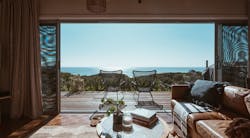The 14 Essential Patterns of Biophilic Design
Recently, wood-project support firm WoodWorks hosted a live webinar on sustainability and biophilic design. The webinar, Wood Buildings: Sustainable Forestry, Biophilic Design and Carbon Footprint, included a presentation from Mike Romanowski, regional director of WoodWorks, on biophilia.
Specifically, Romanowski shared the 14 patterns of biophilic design that were originally published in a report by Terrapin Bright Green, a sustainability consulting firm. For builders and homeowners alike, these patterns offer a look into the many ways biophilic elements can be incorporated into a home.
Here are the 14 patterns that any builder should consider when working on a biophilic home.
14 PATTERNS OF BIOPHILIC DESIGN
Nature in the Space
1. Visual connection with nature
Visually connecting with natural means bringing nature inside the building, and providing views to the outside environment. Having lush greenery near exposed windows offers pleasing views of nature outside the home. Bringing nature inside through the use of natural or manufactured materials—like stone and wood—offer biophilic benefits as well.
2. Non-visual connection with nature
This pattern covers the other sensory connections to nature, besides the visual connection. This includes smell and touch, like the soft texture and pleasing smell of wood, or sound, like a stream of natural flowing water.
3. Non-rhythmic sensory stimuli
These stimuli represent those that are passing or momentary—events that “may be analyzed statistically but may not be predicted precisely,” according to the Terrapin report. Some examples include cloud movement, birds chirping, and plants rustling. The home could benefit from this through devices that automatically (and randomly) disperse plant oils, or maybe ones that broadcast ambient nature noise at unpredictable levels.
4. Thermal and airflow variability
This pattern of biophilic design involves mimicking the subtle changes in temperature, airflow, and humidity of natural environments. A biophilic design for the home might include a specific HVAC delivery system, or special window glazing.
5. Presence of water
Having a sense of ease in the presence of water is a feeling instilled in us by our ancestors. A home with a water wall, fountain, or even simulated reflections of water can make its occupants feel calm and captivated.
6. Dynamic and diffuse light
Dynamic lighting is a part of nature, from sunrise to sunset. Imitating the varying states and intensities of light throughout the day is another pattern of biophilic design.
7. Connection with natural systems
This connection comes from understanding the states of the natural world throughout the year, like the changing seasons, natural processes, and temporal differences. Having a daylighting system in the home could help regulate the circadian rhythm of its occupants, for example.
Nature Analogues
8. Biomorphic forms and patterns
Biomorphic patterns in nature may include the hexagonal structure of beehives and turtle shells, or plants that grow in accordance with the Fibonacci sequence. Incorporating design that mimics the patterns of nature—also known as biomimicry—is another way to reconnect with our natural roots.
9. Material connection with nature
Something as simple as a wooden accent wall, or a neutral interior color palette, helps achieve a connection with nature on a material level.
10. Complexity and order
Nature is both complex and orderly. Making structures that are interesting and unique, while not being too overwhelming, helps adhere to nature’s spatial hierarchy.
Nature of the Space
11. Prospect
Prospect is a freeing sense of space, offering unimpeded views of an area. Think of open floor plans, transparent materials, and elevated planes, as noted by the Terrapin report.
12. Refuge
This is a space to withdraw to. The safety of nature’s nests can be replicated with subtlety—from a high-back chair to reading nooks.
13. Mystery
Through the use of light and shadow, sound, scent, or flow, mystery is a function that conceals information in order to entice someone into exploring further. Find a creative use of space that tempts occupants to investigate the area.
14. Risk/peril
Risks like falling, loss of control, or getting wet can actually serve as exhilarating experiences in some biophilic design elements. Terrapin points to infinity edges, design elements that appear to defy gravity, and the passing under/over water as common features of risk/peril.



